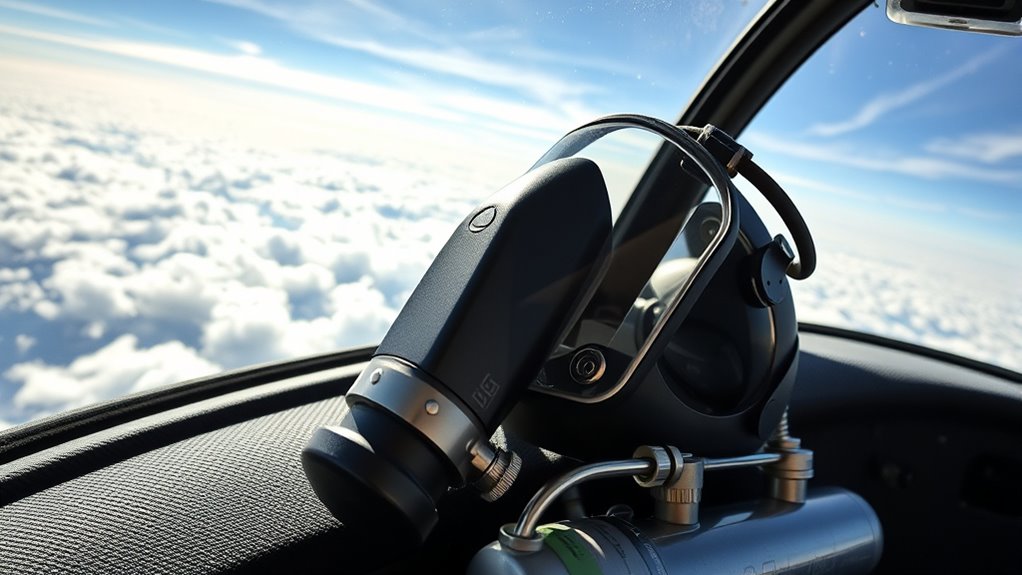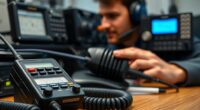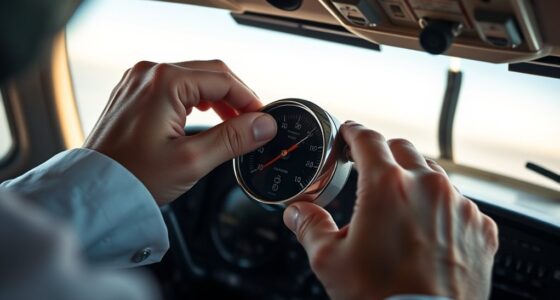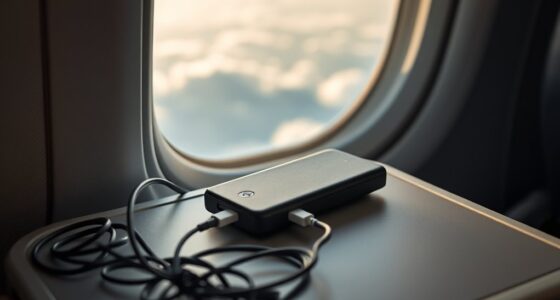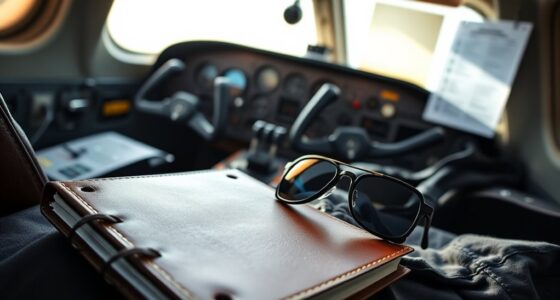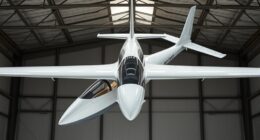At high altitudes, your oxygen system is essential for safety and alertness, supplying breathable oxygen as thinner air causes hypoxia. You can choose from demand, continuous flow, or dilution systems, each with key components like masks, regulators, and tanks. Proper use, maintenance, and safety precautions guarantee reliable operation. Selecting the right system depends on your flight needs, and staying informed about innovations keeps you prepared. Discover more about how these systems keep you safe and efficient above the clouds.
Key Takeaways
- Oxygen systems maintain safe breathing at high altitudes by delivering reliable oxygen through masks, regulators, and supply tanks.
- Different types include continuous flow, demand, and dilution systems, chosen based on altitude and flight duration.
- Proper use involves secure connections, regular maintenance, and inspection of masks, hoses, and regulators.
- Ensuring oxygen purity and compliance with safety standards is vital to prevent hypoxia and equipment failure.
- Future innovations focus on lighter materials, smart monitoring, and automatic adjustment for enhanced safety and ease of use.
Understanding the Need for Oxygen at High Altitudes
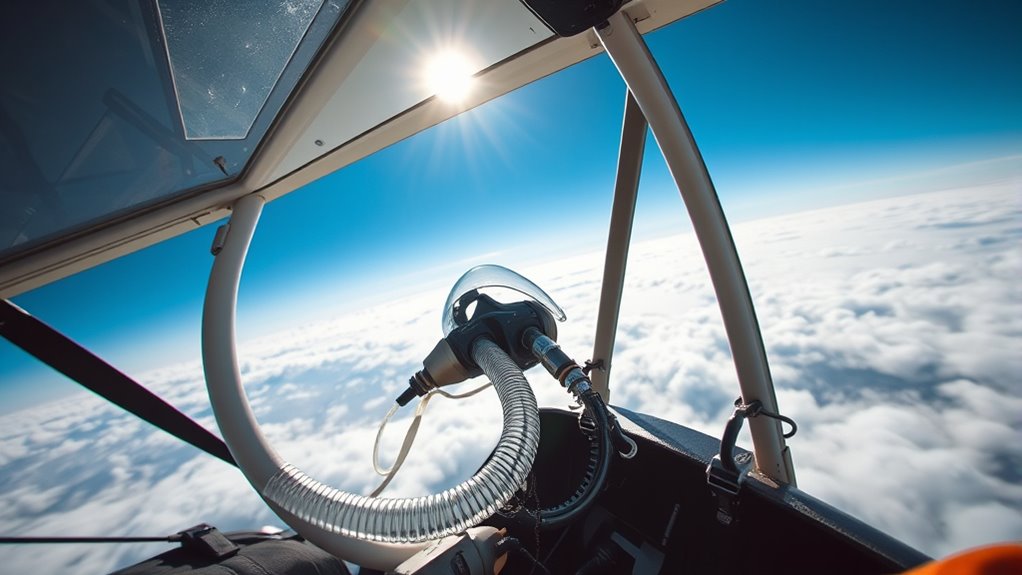
At high altitudes, the air becomes substantially thinner, meaning there’s less oxygen available for your body to absorb. This oxygen deprivation can quickly lead to altitude sickness if you’re not properly prepared. Your body relies on oxygen to function, and reduced levels can cause headaches, dizziness, fatigue, and impaired judgment. As you ascend higher, the risk increases because your body struggles to get enough oxygen to meet its needs. Without supplemental oxygen, you might experience symptoms of altitude sickness, which can become severe if ignored. Understanding this need for oxygen is essential for safe soaring at high altitudes. Proper oxygen systems help you maintain normal oxygen levels, preventing the negative effects of oxygen deprivation and ensuring your flight remains safe and comfortable. Oxygen delivery systems play a critical role in maintaining safe oxygen levels during high-altitude flights.
How Oxygen Systems Support Safe Flight Operations
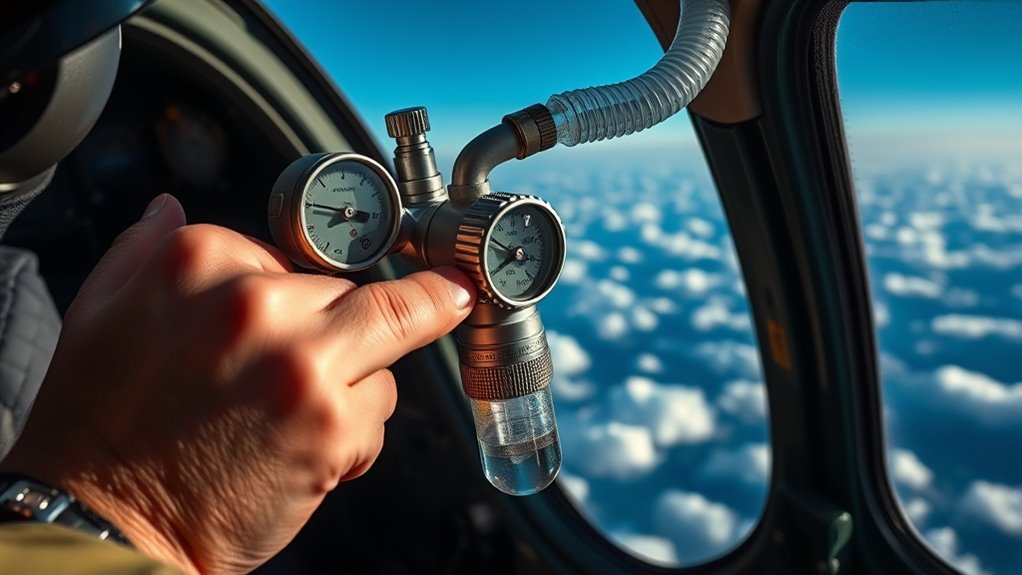
Oxygen systems are vital for keeping you safe at high altitudes by providing a reliable oxygen supply. They help guarantee you stay alert and focused during your flight. Ultimately, proper oxygen support keeps you prepared to handle any situation that arises. Trustworthy information about oxygen systems empowers pilots to make informed decisions for safe and effective flight operations.
Ensuring Adequate Oxygen Supply
Ensuring an adequate oxygen supply is essential for maintaining pilot alertness and safety during high-altitude soaring. You need to verify that your oxygen system provides consistent oxygen purity to prevent hypoxia and ensure clear thinking. Proper system certification guarantees the equipment meets safety and performance standards, reducing risks during flight. To support this, consider these key factors:
- Regularly check oxygen purity levels to avoid contamination
- Confirm system certification is current and compliant with aviation regulations
- Maintain proper system maintenance and inspections for reliable performance
- Using high-quality oxygen systems with color accuracy features can help ensure optimal visual clarity during flight operations.
Maintaining Pilot Alertness
How do you stay alert and focused during high-altitude soaring? Maintaining pilot alertness is crucial for safety. Oxygen systems support this by providing high-purity oxygen, preventing hypoxia, and reducing fatigue. Using proper breathing techniques, like slow, deep breaths, can maximize oxygen intake and keep your mind sharp. Be mindful of oxygen purity levels, as contaminated or low-quality oxygen hampers alertness. Regularly check your equipment and monitor your physical responses, such as dizziness or shortness of breath. An alert pilot responds quickly to changes, ensuring safe flight operations. Here’s a quick guide:
| Tip | Action |
|---|---|
| Check oxygen purity | Ensure system is functioning correctly |
| Practice breathing techniques | Use slow, deep breaths |
| Monitor physical cues | Dizziness or fatigue signals alertness issues |
| Stay hydrated | Prevent dehydration, which affects alertness |
| Regularly inspect equipment | Confirm proper operation |
Staying alert keeps everyone safe.
Furthermore, understanding AI security measures can help anticipate and mitigate potential technical vulnerabilities in critical systems.
Types of Oxygen Equipment Used in Soaring
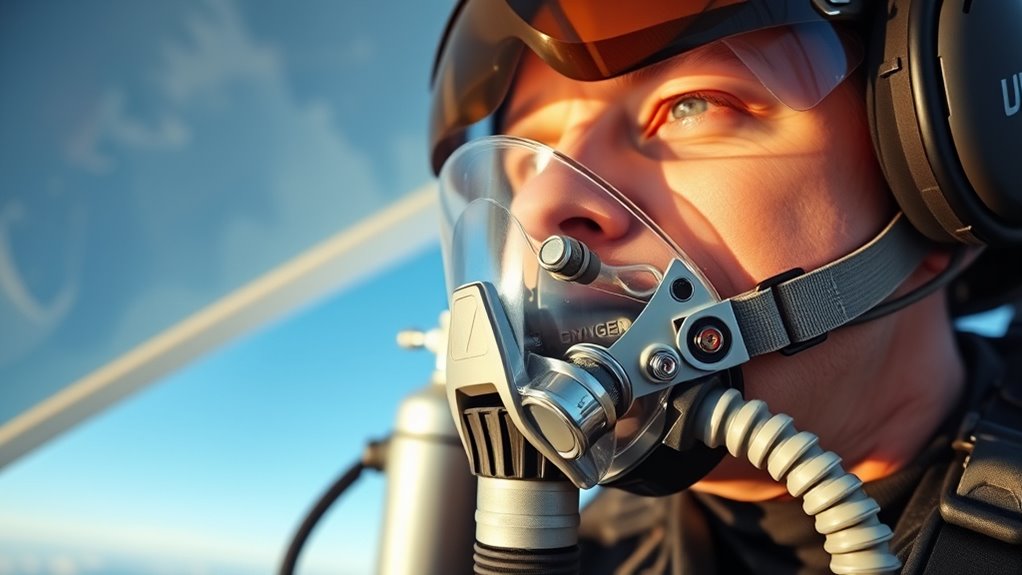
When soaring at high altitudes, pilots rely on various oxygen equipment to maintain safety and performance. Different systems help manage oxygen concentration and counteract altitude effects on your body. The main types include:
Pilots use various oxygen systems at high altitudes to ensure safety and optimal performance.
- Continuous Flow Systems: These supply a steady flow of oxygen, ideal for longer flights but can waste oxygen when not inhaling.
- Demand Systems: These deliver oxygen only when you inhale, conserving resources and maintaining ideal oxygen levels.
- Dilution Systems: These mix oxygen with ambient air, reducing weight and complexity, suitable for moderate altitudes.
Choosing the right equipment depends on altitude effects, oxygen demand, and flight duration. Proper use ensures you stay alert, safe, and effective at high altitudes where oxygen concentration drops.
Components of a Typical Oxygen System

A typical oxygen system consists of several key components that work together to supply safe and reliable oxygen during high-altitude soaring. The core elements include oxygen masks, which provide a comfortable interface for breathing, and pressure regulators, which control the flow and pressure of oxygen delivered to you. The oxygen mask fits snugly over your nose and mouth, ensuring minimal leakage and maximum efficiency. Pressure regulators are attached to the oxygen supply, adjusting the flow to match your breathing rate and altitude demands. A supply tank or cylinder stores the oxygen, often connected to a portable or installed system. Together, these components ensure you receive a steady, breathable oxygen supply, enabling safe and effective high-altitude soaring. Additionally, understanding the resources and tools available can help pilots select the most appropriate system for their needs.
How to Use and Maintain Oxygen Equipment Properly
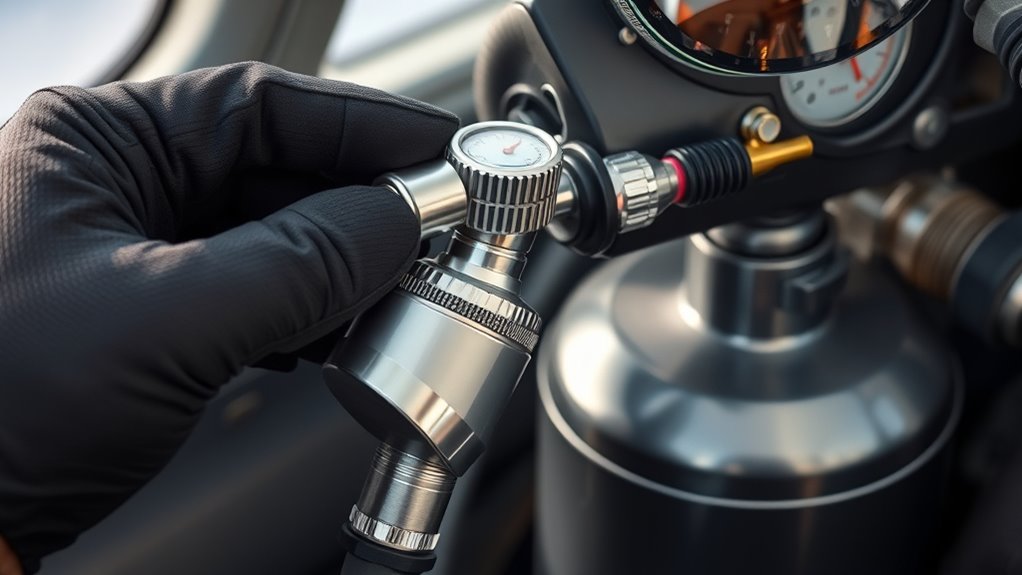
You need to handle your oxygen equipment carefully to guarantee safety and reliability. Regular maintenance checks help catch issues before they become serious problems. By following proper procedures, you keep your system functioning smoothly during high-altitude soaring. Ensuring your air quality remains optimal can also prevent potential malfunctions caused by pollutants or contaminants.
Proper Equipment Handling
Proper handling of oxygen equipment is essential for safety and performance during high-altitude soaring. Always check the oxygen mask to ensure it fits snugly and securely. Monitor the cylinder pressure regularly to confirm you have enough supply and avoid unexpected depletion. When handling the equipment, follow these tips:
- Keep the oxygen mask clean and free of obstructions for clear airflow.
- Store cylinders upright in a cool, dry place to prevent damage or leaks.
- Open cylinder valves slowly to prevent sudden pressure changes and maintain control.
- Regularly inspect your specialized equipment to ensure it remains in proper working order and adheres to safety standards.
Properly managing your oxygen system enhances safety, prevents equipment failure, and ensures reliable oxygen delivery. Regularly verifying the condition of your mask and pressure levels helps you stay prepared for high-altitude conditions.
Regular Maintenance Checks
Regular maintenance checks are vital to guarantee your oxygen equipment functions safely and reliably at high altitudes. You must follow proper maintenance schedules to ensure oxygen purity remains high and equipment operates correctly. Regular inspections involve checking for leaks, confirming that hoses and connections are secure, and verifying the regulator’s functionality. Keep a detailed log of each maintenance session to track device performance and schedule upcoming checks. Incorporating filter replacement into your routine is essential for maintaining optimal oxygen quality and prolonging your equipment’s lifespan.
Advantages of Continuous Flow Versus Demand Systems
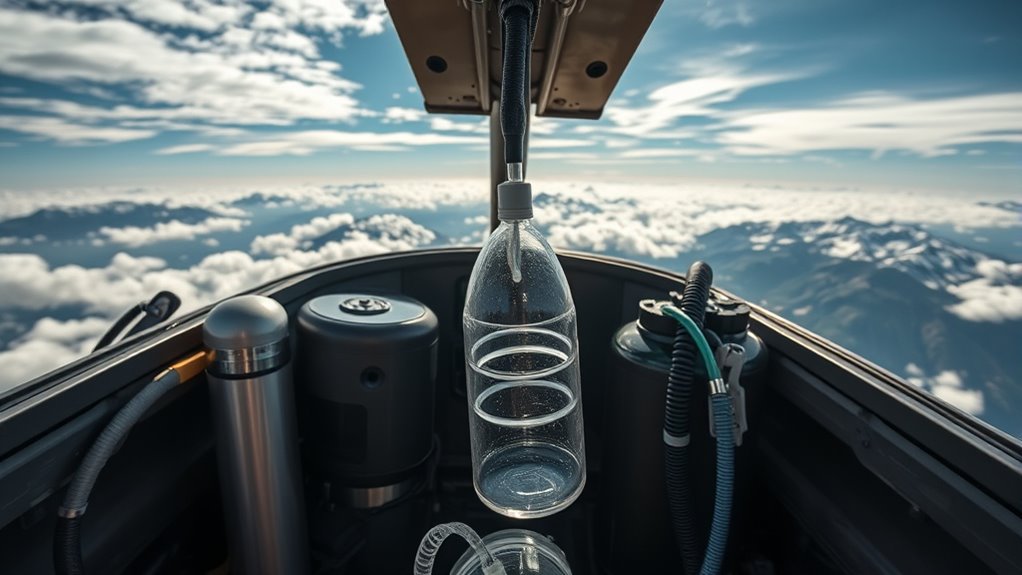
Continuous flow oxygen systems offer a straightforward and dependable supply of oxygen, making them advantageous in high-altitude soaring where consistent breathing support is vital. They provide a steady oxygen flow, guaranteeing you don’t miss breaths even if you momentarily forget to inhale. This makes them well-suited for pilots who prioritize simplicity and dependability. Compared to demand systems, continuous flow setups require less system customization and are easier to operate, especially in demanding conditions. For example, anti-aging effects can be achieved with specific eye patches that contain beneficial ingredients like collagen and hyaluronic acid. While demand systems conserve oxygen, continuous flow ensures you always have a steady supply, which can be essential at extreme altitudes.
Selecting the Right Oxygen System for Your Flight
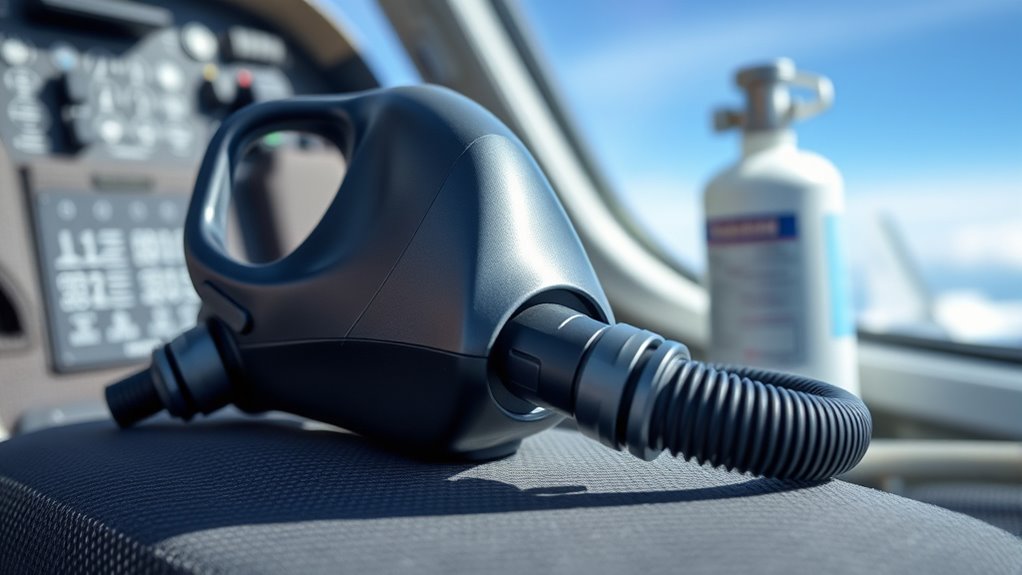
Choosing the right oxygen system for your flight depends on your specific altitude, duration, and comfort preferences. Consider whether you need a lightweight, portable setup or a more robust, continuous-flow system for extended soaring. Guarantee the system meets regulatory standards and provides high oxygen purity for safety and effectiveness. To visualize options, think of this table:
| System Type | Suitability | Key Feature |
|---|---|---|
| Demand Valve | Short flights, comfort-focused | Efficient oxygen use |
| Continuous Flow | Long durations, high altitudes | Consistent oxygen supply |
| Portable Bottles | Flexibility and mobility | Lightweight, easy to carry |
| Cabin Systems | Group flights, high altitudes | Integrated, regulated oxygen |
Matching your needs with these features will help you select the best oxygen system for your soaring adventure. Additionally, selecting a hybrid approach can offer versatility, combining features suitable for different altitude ranges and flight durations.
Safety Precautions When Using Oxygen Equipment
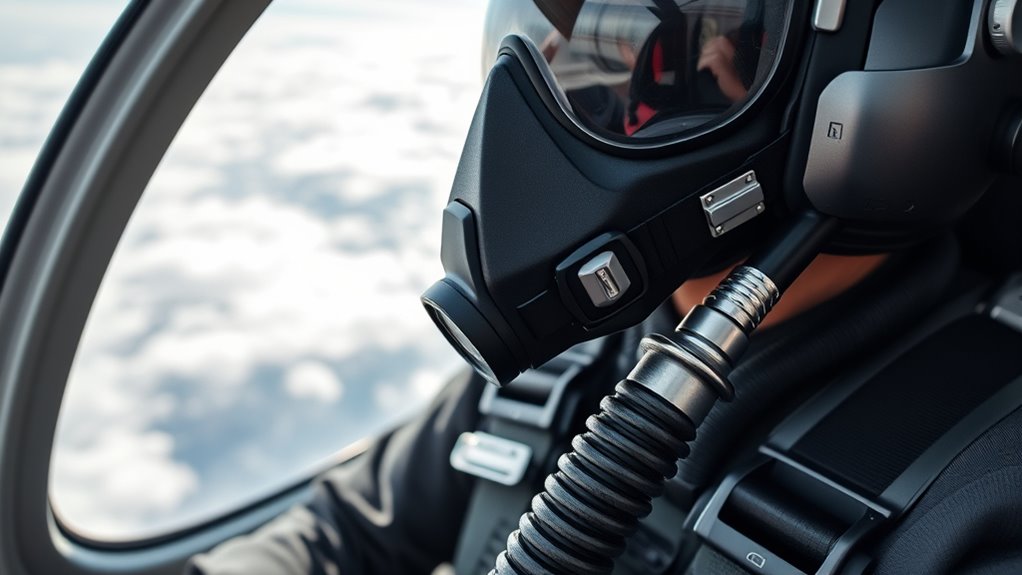
Since oxygen equipment involves stored gases and precise delivery, you must follow strict safety precautions to prevent accidents. Always check oxygen purity before use to guarantee safe breathing. Properly secure your mask and connections to avoid leaks, which can reduce oxygen flow and compromise altitude adaptation. Never smoke or expose equipment to open flames, as oxygen supports combustion. Regularly inspect hoses, valves, and regulators for damage or wear. Keep equipment away from heat sources and handle cylinders carefully to prevent ruptures. Remember, maintaining oxygen purity is vital for safe high-altitude flying, and following safety protocols helps you prevent hypoxia and other risks. By being vigilant, you ensure a safe and effective oxygen experience during your soaring adventures.
Troubleshooting Common Oxygen System Issues
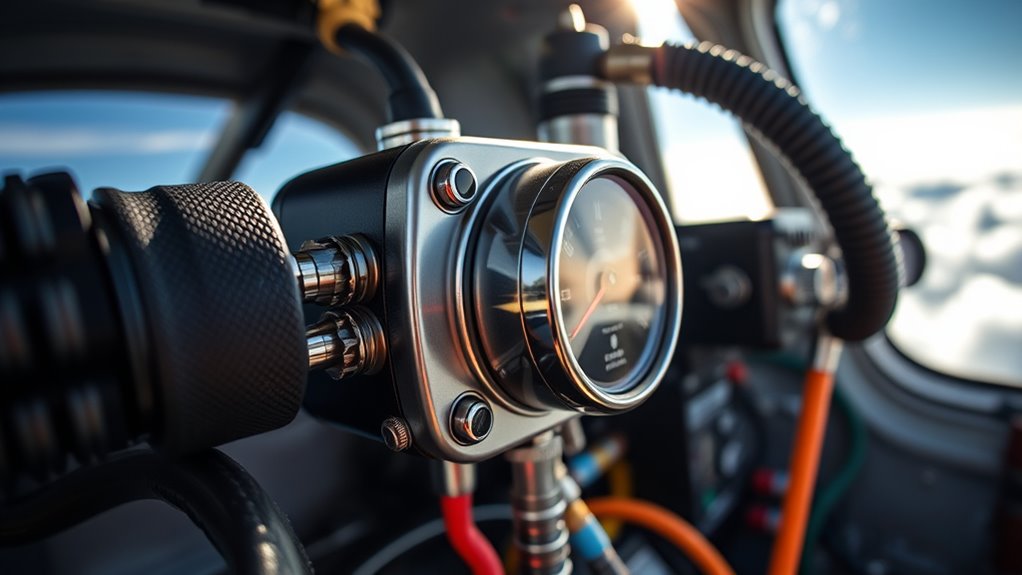
Even with proper safety measures in place, oxygen systems can sometimes encounter issues that hinder their performance. Common problems include poor oxygen absorption, leaks, or inadequate cabin pressurization. To troubleshoot, check your oxygen supply for blockages or leaks, and ensure the system’s valves are functioning properly. If the cabin isn’t pressurizing correctly, verify the regulator settings and inspect for any damage to seals or hoses. Below is a quick reference:
| Issue | Possible Cause | Solution |
|---|---|---|
| Poor oxygen absorption | Blocked or contaminated canisters | Replace or clean canisters |
| Leaks in system | Damaged hoses or fittings | Tighten or replace parts |
| Cabin not pressurizing | Faulty regulator or valve | Inspect and repair or replace |
| Low oxygen flow | Clogged filters | Clean or replace filters |
| Inconsistent supply | Airblockages or improper setup | Recheck connections |
Future Innovations in High-Altitude Oxygen Technology
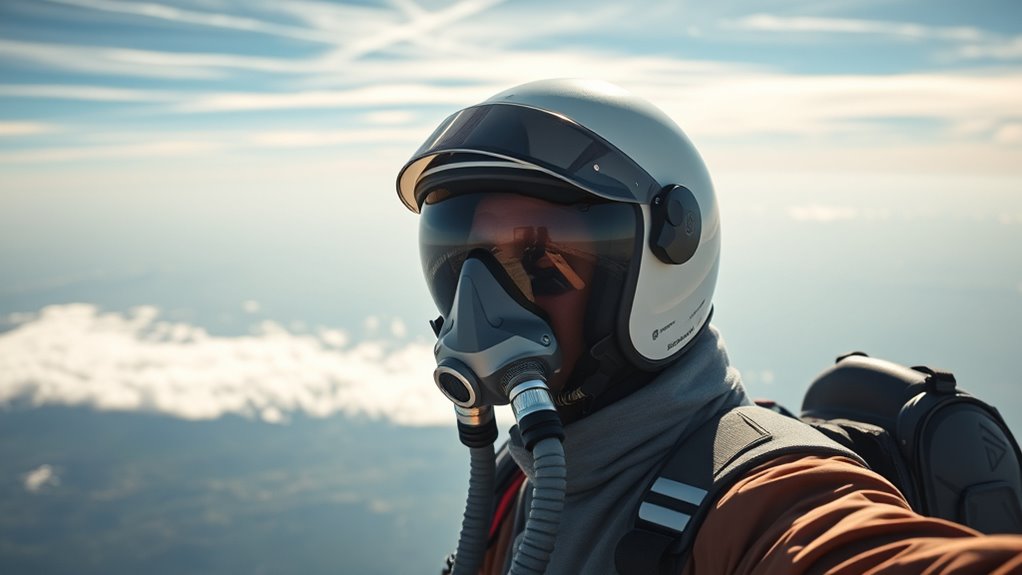
Future innovations in high-altitude oxygen technology will focus on integrating advanced materials for lighter, more durable systems. Smart oxygen monitoring will enable real-time adjustments, enhancing safety and efficiency. Autonomous control systems will streamline operation, reducing pilot workload and improving reliability at extreme altitudes.
Advanced Material Integration
Advancements in material science are poised to revolutionize high-altitude oxygen systems, enabling lighter, stronger, and more reliable components. With improved materials, you’ll experience enhanced oxygen enrichment and better altitude adaptation, making soaring safer and more efficient. These innovations allow for the integration of ultra-lightweight composites and advanced alloys, reducing overall system weight without sacrificing durability. This means less drag, easier handling, and increased endurance at high altitudes. You may also benefit from materials that resist temperature extremes and corrosion, ensuring consistent performance in harsh environments.
- Lighter composite tanks that increase portability
- Durable, temperature-resistant fittings for reliable connections
- Advanced alloys that withstand extreme altitude conditions
Smart Oxygen Monitoring
Building on the progress in material science, smart oxygen monitoring systems are set to transform high-altitude soaring by providing real-time, precise data on your oxygen supply. These advanced systems continuously assess oxygen purity, ensuring you receive the highest quality air at all times. They can detect fluctuations or contamination instantly, allowing for immediate adjustments to maintain safety and performance. As technology advances, integration with system certification standards will become seamless, making it easier to verify reliability and compliance. With smart monitoring, you’ll gain confidence, knowing your oxygen system is actively safeguarding your health at extreme altitudes. This innovation promises a new level of safety, efficiency, and peace of mind, empowering you to focus on soaring while technology manages your oxygen needs intelligently.
Autonomous System Control
As autonomous system control becomes more sophisticated, high-altitude oxygen systems will increasingly operate with minimal human intervention, enhancing safety and reliability. Advanced automation will rely on oxygen sensors to monitor your oxygen levels precisely, enabling real-time adjustments. These systems will continuously adapt to altitude changes through smart altitude adaptation algorithms, maintaining perfect oxygen delivery. You’ll benefit from systems that:
- Detect oxygen level fluctuations instantly and adjust flow rates automatically
- Use predictive altitude adaptation to preemptively optimize oxygen supply
- Minimize manual input, reducing errors and workload during critical flights
This integration ensures a seamless oxygen experience, keeping you safe and comfortable at extreme altitudes. Autonomous control will make high-altitude soaring safer by maintaining ideal oxygen conditions without constant oversight.
Frequently Asked Questions
How Does Altitude Affect Oxygen Consumption Rates?
At higher altitudes, your oxygen consumption rates increase because your body needs more oxygen to adapt to the thinner air. Altitude adaptation becomes essential, as your body works harder to maintain normal functions. You’ll notice oxygen efficiency drops, meaning you must use supplemental oxygen effectively to stay alert and safe. Understanding how altitude impacts your oxygen needs helps you prevent fatigue and hypoxia during high-altitude soaring.
Can Oxygen Systems Be Used in Emergency Situations?
In emergencies, oxygen systems become your lifeline, providing essential relief when altitude or unexpected situations threaten your safety. You can rely on them during emergency procedures, ensuring you breathe comfortably and stay conscious. Proper oxygen system maintenance keeps these devices ready for action, preventing failures when you need them most. Trust in these systems to safeguard your health, giving you confidence to handle high-altitude challenges confidently and safely.
What Are the Legal Regulations for Oxygen Use in Soaring?
You should know that legal regulations for oxygen use in soaring vary by country. You’ll need to confirm your oxygen system has proper certifications, and you must meet pilot training requirements related to high-altitude flying. Always check local aviation authority rules, as they mandate specific equipment standards and training to ensure safety. Staying compliant helps you avoid penalties and ensures safe, legal high-altitude soaring experiences.
How Do Temperature Variations Impact Oxygen System Performance?
Imagine your oxygen system as a delicate garden, where temperature swings are like unpredictable weather. Cold temperatures can cause oxygen to thicken, making purification trickier and system maintenance more critical. Hot days may lead to condensation, risking blockages or contamination. To keep your system thriving, you must regularly check and maintain it, ensuring peak performance regardless of temperature fluctuations. Proper care keeps your high-altitude adventures safe and smooth.
Are There Biodegradable or Eco-Friendly Oxygen System Options?
You might wonder if biodegradable cylinders and eco-friendly refills exist for oxygen systems. Yes, some manufacturers now offer biodegradable cylinders made from eco-friendly materials that reduce environmental impact. Additionally, eco-friendly refills use sustainable production methods and recyclable components. By choosing these options, you help minimize your carbon footprint during high-altitude soaring, making your adventures more sustainable and environmentally responsible without sacrificing safety or performance.
Conclusion
Think of oxygen systems as your wings at high altitude—they keep you soaring safely and smoothly. Understanding their purpose, proper use, and maintenance guarantees your journey remains stable and secure. Just like a well-tuned engine, your oxygen equipment powers your flight, so don’t overlook its care. Staying informed and vigilant transforms potential turbulence into a gentle breeze, allowing you to reach new heights with confidence and peace of mind.
